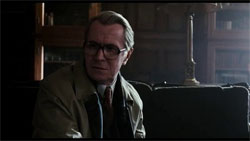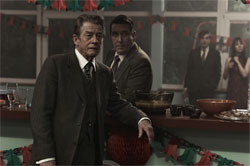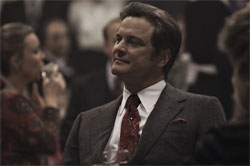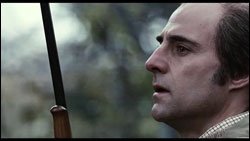This might be an excellent movie; it certainly looks impressive. But I’m only a little less baffled now, after reading up on the storyline, than I was when I walked out of the theater. Suffice it to say that reviews by people who had already read the novel, or viewed the 7-part BBC series, regard the movie with great appreciation. Those who didn’t already know the storyline range from appreciative-but-puzzled to frustrated-and-annoyed.
The central problem may be hinted at, above; a story that takes 400 pages in print, and five-plus hours on TV, is going to be cryptic at a smidge over two hours. It’s a spy story, so cryptic is apropos, but give us a break: in addition to the intended mystery (who’s the mole at the top of British intelligence?), there’s a deluge of elements that are mysterious simply because too much is going by too fast. It’s fun to puzzle out a movie mystery, but the game is playable only if you’re able to gather and assemble the clues as they’re dropped.
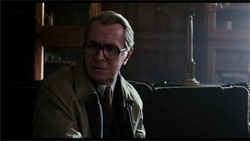
The story takes place in London, at the Secret Intelligence Service, a modern building ingeniously concealed in the spacious inner courtyard of a large but nondescript, block-square outer building. There are a lot of characters, nearly all white men in suits. The story opens with “Control,” chief of the Service (called “the Circus,” for its location at Cambridge Circus), sending one of their “scalphunters” (agents trained for dirty work) to Budapest to meet with a communist general who wants to defect. But things go disastrously wrong, and Control is forced to retire, as is his “right hand man,” George Smiley.
However, a senior government official contacts Smiley (Gary Oldman) privately and asks him to investigate a choice bit of information: there is a double agent at the top of the Circus. At that rank there are four possible candidates: Percy Alleline, Bill Haydon, Roy Bland, and Toby Esterhase (and many thanks to the casting director, who chose for these roles four actors very different in appearance). Control has by now died, but Smiley and his assistant Peter get into his apartment and find that he, too, suspected a mole. He nicknamed them “Tinker, Tailor, Soldier, Spy,” after the English version of the children’s rhyme that begins “Rich man, poor man” in the U.S. There are four chess pieces on Control’s desk, and taped to each one is a photo of a suspect: Alleline (Toby Jones), Haydon (Colin Firth), Bland (Ciarin Hinds), and Esterhase (David Dencik). Make that five chessmen: the fifth bears a photo of Smiley.
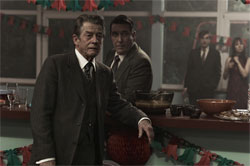
It’s a beautiful film, visually. The ’70s décor, clothing, and music has been perfect executed, and the rainy streets and falling leaves create a mood of quiet poignancy. Though there are episodes of violence and action (and some hideous brief shots of dead bodies), they’re over quickly; we are continually being returned to a very still, calm world, as Smiley puts together clues with the patience of a watchmaker. Though he surely has wounds—early in the film, another character says, “I heard Ann has left you again”—he is consistently unemotional, both alert and tranquil.
Oldman’s portrayal creates a center of gravity that the whole film orbits around. It’s quite a change of pace for the actor whose other roles include Sid Vicious, Lee Harvey Oswald, Dracula, Sirius Black, Elvis, Pontius Pilate, and the Devil. The director, Tomas Alfredson, was best known previously for Let the Right One In (2008), a teen-vampire movie. You’d never know it.
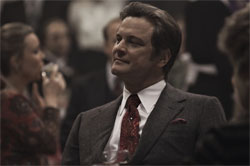
There’s much to praise, artistically, but the movie is hampered by the opacity of the plot. I had an unfair assist in that our screening audience was given a handsome printed folio, resembling a top-secret briefing document, that set up the premise and included photos, rank, and names of many of the main players (13 of these characters were included, but that turned out to be only a start). It also included a glossary of code names, like “scalphunters,” and helpful information such as “Each floor of the building represents a different … level of security …. [W]orkers on a floor other than their designated one will immediately appear out of place and/or suspicious.” Nice to know, but I expect most moviegoers won’t receive this cheat sheet, and be even more lost than I was.
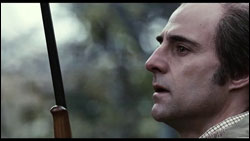
The ending wasn’t an absolute surprise; there were enough hints along the way. But what puzzles me, as I think back, is the great number of other things that happened that I still don’t know how to fit into the story. How do you solve the problem of a movie that is not only suspenseful, but impenetrable? Do you read up on the storyline before going to see the film? But would you really want to entirely spoil the plot? It’s a dilemma. One reviewer said that he found the first viewing baffling and the second illuminating; I expect that’s a solution the studio would most heartily endorse.
Talk About It
Discussion starters- Smiley visits a retired colleague, Connie, and they look over photos from their time together in the service. Connie says, “It was a good time back then,” and Smiley remonstrates, “It was a war, Connie.” She says, “A war we could be proud of.” The Cold War that followed was, by contrast, a time of debilitating anxiety, with few clear courses of action. Is “a war we could be proud of” a better thing?
- Early in the film a bee in a car annoys characters who swat at it, but Smiley calmly opens a window and lets it out. Later, another character has an encounter with an owl that doesn’t go as smoothly. Do you think these scenes are meant to be viewed in contrast, revealing different sides of the characters?
- The publicity folio defines “Scalphunters” as the “Section of the Circus that deals with the darker side of the job; blackmail, burglary, kidnap and assassination.” Do you think our nation’s intelligence has such a section? Should it?
The Family Corner
For parents to considerTinker Tailor Soldier Spy is rated R for violence, some sexuality/nudity, and language. Too much violence for little ones, and some revolting shots of murder victims. Some nudity in a long-shot sex scene and slurpy close-up kissing.
Photos © Focus Features
Copyright © 2011 Christianity Today. Click for reprint information.

